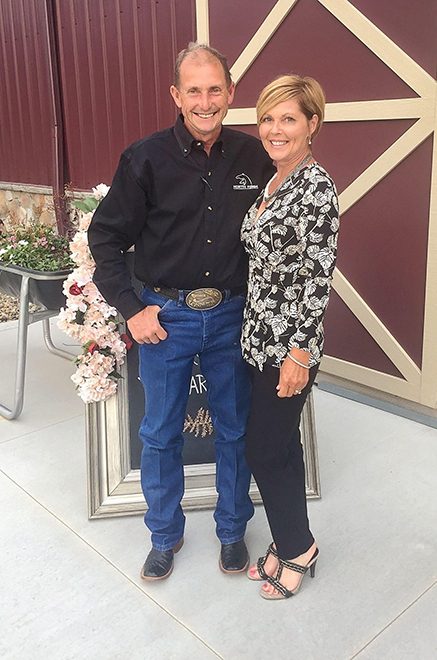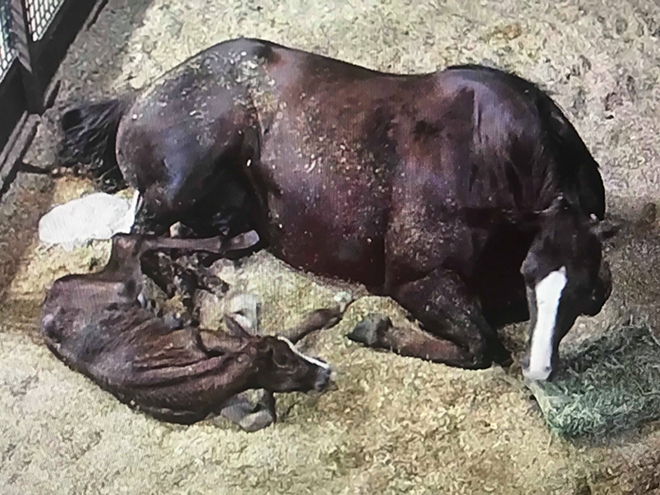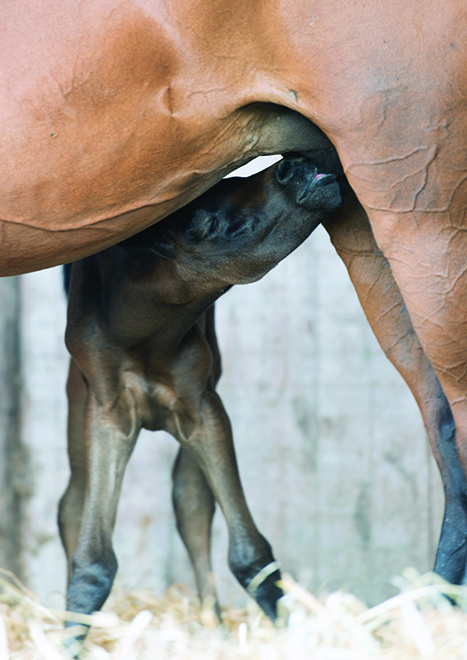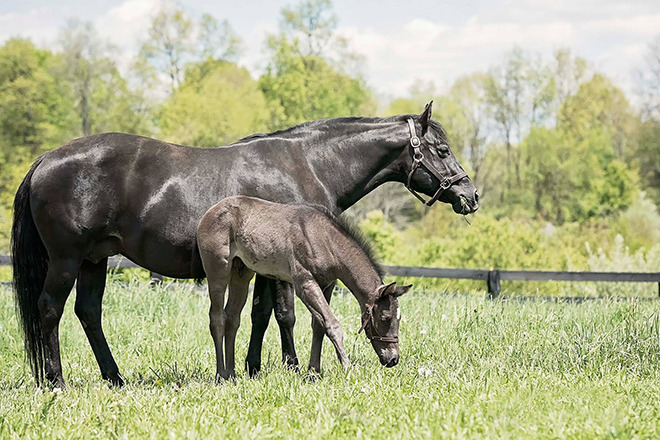
You carefully selected a stallion that will cross just right on your show mare. You worked closely with your veterinarian, provided the proper nutrition and patiently waited for 11 months. If all goes as planned, once the foal arrives your mare will lick it, nicker to it and defend it from perceived danger. But when the day finally arrives, your mare’s vicious squeals pierce the air. She lunges at and bites the foal.
Fortunately, all-out rejection is a rarity according to several long-time breeders. Sara Lawley is the breeding manager at Backes Quarter Horses in Tioga, Texas. She’s foaled out thousands of mares at Backes, Joan Schroder’s Kiowa Ranch and National Reining Horse Association Hall of Fame member Tim McQuay’s facility.
“I’ve not seen one mare absolutely reject a foal,” she said. “In some instances, it may take the mare a little bit to calm back down after delivering, but they eventually figure it out.”
Shelley Donovan of BSB Quarter Horses in Sturgis, Michigan agrees that rejection is uncommon. In her more than 30 years of foaling, she has only seen one mare truly refuse to accept its foal. And that was at a customer’s barn.
“They called in a panic saying she was trying to kill the baby because she was biting and kicking,” Donovan said. “By the time we got there they had them separated with the baby outside the stall.”

At Debbi Trubee’s North Farm in North Lawrence, Ohio she watches maiden mares for signs of rejection before a mare even foals. A mare that snarls at other foals or doesn’t show interest in babies being led by her stall signal that the mare may not be the best momma once the baby arrives.
“Once a maiden mare foals, if she doesn’t show any interest in the foal while she’s still down it raises red flags,” she said. “In these situations, we pull the babies around to the front of the mare after she foals so we can see how she interacts with the baby while she’s still laying down. A mare that shows no interest, doesn’t lick or talk to the baby will be one that we are very cautious with once she gets up.”
Even though all-out rejection is infrequent, it is a reality for some mare owners. When it happens it’s stressful for the mare, the foal and the owners. The behavior can have adverse effects on the foal – limiting its crucial access to colostrum and/or increasing its risk for physical injury. Recognizing the signs of rejection and responding as needed protect the well-being of your mare and foal.
Rejection from pain and hormones
A mare’s age and her experience as a broodmare influence the chances for rejection. Young and first-time mothers are more likely to reject a foal than older mares who have delivered multiple foals.
“I can’t really say why some mares may reject their first foal other than it’s a hormone issue or their pain is so great that they may be a little in shock right after foaling,” Trubee said. “We have had mares that were horrid with their first foal and went on to be great mothers to their babies after the first one.”

Pain, specifically a sore udder, makes some mares hesitant to accept the foal. Maiden mares aren’t used to the pressure on the bag when a foal pushes down to nurse and when the foal goes to nurse, the discomfort triggers rejection.
At Rough Woods Ranch in Eldora, Iowa Jamie Teske had one mare that needed to have the pressure pumped off every 30 minutes for nearly 12 hours.
“Her bag was so tight that it was painful when the foal nursed. The foal was “punishing” her when she was trying to mother it. It was teaching her not to,” Teske said. “Alleviating the pressure and a little luck it all came together.”
In extreme cases, Trubee says it may be necessary to hobble or tie the mare to a wall. Sedation may also be needed to keep the baby safe while the mare learns to accept her baby. A barricade or stocks are other options for restraining an aggressive mare.
Donovan said when one of their customers called because their mare was attacking her foal she and her partners went to the rescue.
“We brought the mare to our house, snubbed her close to the wall, hobbled her and put her food and water where she could reach. We also put up a board so she couldn’t move but her foal could nurse,” Donovan said. “On the 10th day the baby nickered she nickered back and they were good. The customers sold the mare, but she went on to have several more babies with no problems.”
Before foaling day arrives, Lawley prepares mares, especially sensitive mares, through routine testing and monitoring of the mare’s milk. She measures the pH a few times a day, which gets the mares used to having their udders handled.

“If it’s your mare’s first foal and she’s touchy to begin with, rubbing her udders in advance of the foal get her used to it,” Lawley said.
Laurie Kuchler of Little Shadow Farm in Sunbury, Ohio keeps the barn’s first aid kit stocked with Banamine. Based on recommendations from her veterinarian she gives the medication to alleviate udder pain and encourage the mare to allow a foal to nurse.
“Once the foal is nursing, the pressure is reduced and everything will be fine,” she said.
Maiden mares seem to have the most trouble accepting their new foals. Oklahoma based breeder Michele Dare has experienced two rejections, both by maiden mares. The first mare wanted to kill the foal.
“We tried for two weeks to get her to accept the foal without any luck. Oxytocin didn’t work and neither did sedation,” she said. “Actually sedation made her more violent towards the colt. We used a divider with a cutout in it that allowed the foal to nurse until we found a nurse mare.”
The nurse mare had just lost a foal so Dare gave her oxytocin, rubbed the mare’s sweat all over the colt, and she bonded with him almost instantly.
With Dare’s second mare, she again used the divider and tried oxytocin again, but at more frequent intervals. Instead of medicating the mare once, she received oxytocin daily and was not sedated.
“Each day we learned a little more about how this drug was affecting her,” Dare said. “The trick was giving her the oxytocin, taking her away for 30 minutes, then bringing her back in and rubbing her sweat all over him. We had not been waiting long enough the prior two days.”
Other reasons for rejection
Hormones, pre-existing medical conditions and inexperience are documented reasons that mares have rejected their foals. But breeders have experienced a wide range of behaviors that have interrupted a mare’s maternal instinct. Marilyn Mowry Bowling once showed in all-around events, but now breeds for reining, cutting and cow horse. She had a maiden mare bond with the placenta rather than the foal.

“The baby was up and wandering around. The mare cleaned and I removed the placenta from the pen,” she said. “The mare attacked the baby and tried to bond with the placenta. She kept chasing the baby away from the placenta. I had to put it back into the pen, on top of the foal, and then she was fine. It soon fell off the foal and I snuck it out of the pen.”
Sometimes Mother Nature thwarts the best laid plans. Kimberly Dowdle of Chandler, Oklahoma had a maiden mare deliver a foal outside in a paddock during a hard rain. Dowdle was at work when the mare delivered. When she returned home, the foal started screaming at her. She brought the mare and foal into a stall and the mare refused to acknowledge the foal. She tried pinning the mare into the corner and twitching, but the mare continued to act vicious, trying to bite and kick the foal.
“My opinion is the rain washed her mom’s scent off and she did not know what the baby was,” she said. “We used a surrogate and have the mare rebred for 2019 and praying she accepts this foal.”
In many cases, Lawley believes that human interaction can contribute to rejection. She limits her interaction with mares during and immediately following. She keeps the lights in the barn to a minimum and tries to keep the barn as quiet as possible.
“A mare’s natural instinct is to go hide and be alone when she delivers,” Lawley said. “Going in before the mare has committed to pushing can delay delivery by up to an hour.”
That doesn’t mean she leaves the mare on her own. She watches the progress from a foal camera and once the mare is down and pushing, Lawley sneaks into the stall to make sure the feet are pointed down and in the foal is in the correct position. Once she sees the sac she exits the stall and observes just out of sight.
“Too much human interaction can be a bad thing,” she said. “Once the foal is up and nursing I leave them alone to bond. I’ll check on them for the next few hours, but don’t go in and interact with the foal until the next day.”
Even the most well-intentioned interactions can have unintended consequences. Bowling recounted an incident with an Appaloosa maiden mare owner who called the ranch looking to buy colostrum. Bowling asked the customer what had happened. The mare wouldn’t allow the foal to nurse. The veterinarian had been out and they tried the usual- twitching, sedation, medication, etc, but nothing had worked.
“I was almost ready to hang up when she mentioned the blanket,” Bowling said. “It had just been washed in Tide. She said it smelled so clean. When she took it off and the mare was fine, but with the blanket on the mare couldn’t recognize the foal. It wasn’t even cold but people want to put those “cute” blankets on them.”
We try to stay away while the mare is down to let her bond with the foal and have as little distractions as possible.
Advice for mare owners
It’s important to be able to recognize that a mare needs additional time to bond with her foal and when the foal is in danger of being injured.
“There are times that you’ll think a mare is being aggressive when she nips at the ears or bites at the foal, but horses can be a little rough,” Lawley said. “When the mare’s behaviors are going against anything you’ve read that’s when you need to call the vet, tie her up and put the foal in a corner.”
It takes a lot of patience and tough love to work through rejection. Donovan says that mare owners going through a rejection should do what they are comfortable doing.
“We know these girls have a job to do, and we will go pretty far to make sure they do that job,” she said. “Folks with pet mares may not be able to get aggressive enough with their girls to get them to accept.”
In most cases, the mare’s maternal instinct will kick in and take over, but that’s not always the case.
“Most mares will settle in to motherhood in a few days but there are some that simply should not be allowed to keep the foal. An experienced person will be most able to determine that,” Trubee said.



You must be logged in to post a comment Login